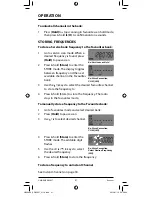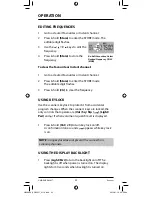
7
UNIDEN EZI33XLT
Scanner
This section provides you with background on how scanning
works. You don’t really need to know all of this to use your scanner,
but some background knowledge will help you get the most from
your EZI33XLT.
WHAT IS SCANNING?
Unlike standard AM or FM radio stations, most two-way
communications do not transmit continuously. Your EZI33XLT
scans programmed channels until it fi nds an active frequency,
then stops on that frequency and remains on that channel as
long as the transmission continues. When the transmission ends,
the scanning cycle resumes until the scanner receives another
transmission.
CONVENTIONAL SCANNING
Conventional scanning is a relatively simple concept. Each
group of users in a conventional system is assigned a single
frequency (for simplex systems) or two frequencies (for repeater
systems). Any time one of them transmits, their transmission
always goes out on the same frequency. Up until the late 1980’s
this was the primary way that radio systems operated.
Even today, there are many 2-way radio users who operate
using a conventional system:
•
Emergency Services (Police/Fire/Ambulance)
• Freenet
• PMR
• Marine
Radio
• Aircraft
•
Many business radio users
When you want to store a conventional system, all you need
to know is the frequencies they operate on. When you are
scanning a conventional system, the scanner stops very
briefl y on each channel to see if there is activity. If there isn’t,
the scanner quickly moves to the next channel. If there is,
then the scanner pauses on the transmission until it is over.
WHERE TO OBTAIN MORE INFORMATION
By itself, this manual really only provides part of what you need to
know to have fun scanning – how to program and use the scanner.
UNDERSTANDING SCANNING
UB366AV_EZI33XLT_0119.indd 7
UB366AV_EZI33XLT_0119.indd 7
2012/01/19 20:58:19
2012/01/19 20:58:19








































